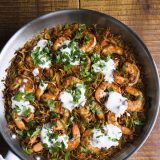Soon-to-be grandmother Mari Carmen Oliete Clemente fusses over her fideuà in her Barcelona kitchen, tweaking by the pinch, aromas guiding her. By the time I arrive, she has been chopping, steaming and simmering for nearly two hours. Crimson shrimp with heads intact sit on the counter alongside squid stewed in its own ink with onion and tomato.
The meal is similar to a seafood-rich paella, but with pasta instead of rice. And it has drawn Catalan families together on Sunday afternoons for centuries. But today, it also is a lesson. She is teaching the dish to Irina, her Russian daughter-in-law, as well as her own daughter, Gemma—both pregnant, both expecting girls.
Clemente looks over the top of her tortoise shell glasses to supervise Irina as she pours dry noodles—thin as angel hair pasta and about an inch long—into a wide, shallow skillet popping with hot oil. Rockfish fillets simmer in liquid on the next burner; their broth will soften the toasted noodles once they reach a mahogany brown.
Irina adds the fish stock to the noodles, reduces it and pours in a little more before Clemente slides the skillet into the oven. Minutes later, the noodles come out crispy, brown and smelling of roasted walnuts. The noodles have sopped up the stewed squid and fish broth, but the dish feels earthy; there’s a deep, nutty richness drawn from hours of layering flavors.
Clemente’s treatment of the pasta—toasting it to draw out its nutty aromas and flavors, then cooking it in the flavorful broth before finally popping it in the oven to brown—deepens the flavors while crisping the finished dish.
We loved Clemente’s recipe for the way it added depth and texture to everyday ingredients. We pared down the list of seafood to only shrimp, which we seared, then tented with foil to gently finish cooking in their residual heat. Once it came out of the oven, our fideuà was studded with toasted bits of pasta on the top, a contrasting texture to the richness of the nutty noodles underneath.




